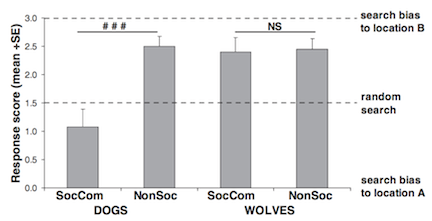Learning and Domestication
Biology 342 | Fall 2014
How Interaction with Humans has Altered Animal Behavior
Mara Kaiser and Michael Weiss
Adaptive Value of Heterospecific Communication
The initial adaptive value of increased perception of human social cues, such as pointing, was likely due to selective breeding of dogs by humans. Dogs that were more tame and more perceptive were more likely to be bred by humans, increasing their lifetime reproductive fitness. However, once domestication had occurred, these traits had other benefits for both humans and dogs. Effectively interpreting communication signals from humans allows dogs and humans to complete cooperative problem-solving tasks [6]. While dogs have a higher innate ability to follow human social cues such as pointing [11], wolves and other wild canids are better at imitating conspecifics [7]. This is likely because dogs, unlike wolves, were selectively bred into a situation in which their “pack-mates” were not other canines, but humans, making communication with humans a much higher priority than communication with other dogs, unlike wolves which primarily communicate with one another. There may also be developmental effects at play, as developing dogs are exposed to conspecifics less than developing wolves . In some cases, this reliance on human social cues can actually be detrimental to a dog’s problem solving capability, if the social cues from the human are not “honest.” For example dogs, unlike wolves, commit the “A-not-B” search error. This error occurs when a human, in full view of the dog, places a treat under cover “A,” and gives dogs the social cues indicating where the treat is. The dog will search area “A.” However, when faced with the same choice later, even when the dog sees the trainer place the treat under cover “B,” the dog will still search A. Interestingly, this search error is also commonly observed in human infants.

Response of dogs and wolves in choice tests after first finding their target in location A, and then being shown the target being moved to location B. SocCom animals were given social cues suggesting that the treat was in location A, while NonSoc animals were not. Search bias towards location A indicates an “A-not-B” search error. From Topal et al.
Studies have shown that this phenomenon is linked to dogs’ interpreting social signals from the human placing the food [10]. So, while social signals can help dogs to solve problems, it can also limit their ability to solve problems on their own, which may be detrimental if human signals are not “honest.”